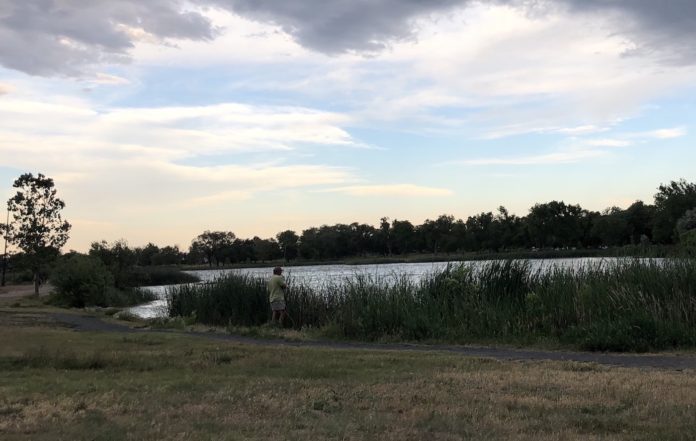
Thanks to stocked ponds in Denver parks, you can fish in Colorado without having to leave the city.
•
Colorado’s thousands of miles of rivers and streams might be famous for fishing. Here on the high plains (read: semi-desert), however, opportunities to drop a line in the water aren’t quite as obvious. Sure, there’s the South Platte River. But with all due respect to the waterway that birthed the Queen City, the former trash, sewer, and still occasional scooter dump does not exactly appeal to would-be anglers with a healthy respect for giardia and cryptosporidium. Plus, river fishing is hard.
Fortunately for urban anglers, many of Denver’s city and mountain parks contain ponds and reservoirs that Colorado Parks and Wildlife (CPW) fills with possible catch on a regular basis. “CPW stocks around a dozen ponds and lakes in Denver,” says Vicki Vargas-Madrid, wildlife program administrator for Denver Parks and Recreation. “These opportunities have long been in our park system, but even people who have these neighborhood gems in their backyard don’t always know.” Translation: You’ve got a lot better chance of turning your “fishing” outing into a “catching” excursion at one of our city’s water features.
Among Vargas-Madrid’s favorite parks to fish: Sloan’s Lake Park, Rocky Mountain Lake Park, Berkeley Lake Park, Barnum Lake, Washington Park, and Garfield Lake Park. Among other species, they’re brimming with pumpkinseed, green sunfish, and—early in the summer—trout (these trophies don’t do well in warm water, so they’re generally only stocked through early summer). You can keep tabs on when your favorite fishing hole was last topped off with CPW’s stocking report, a searchable database of when every pond, lake, and reservoir in the state was last filled—typically at least once a month—and with what.
You’ll still need a fishing license ($35 for the year) if you’re older than 16, and most of Denver’s park fishing is best for baited as opposed to fly fishing, though you’re welcome to try the latter. And all the standard fishing rules, including size and catch limits, still apply—but you can keep your city-caught bounty for supper if you’d like. Worried about city grit getting into your fish? Vargas-Madrid isn’t. “The fish are coming from hatcheries where they are nice and healthy and plump,” she says. “They don’t overwinter, so they don’t have an opportunity to really ingest any contaminants.” (You can also check the recommendations regarding the safety of eating the fish in your water at the Colorado Department of Public Health and Environment’s website.)
Don’t be surprised if the banks are a little more crowded this summer: COVID-19 has inspired more residents to pack their poles and head for nearby holes. But fellow social distancers aren’t your only competition. Cormorants and herons do their own fishing at City Park, pelicans prowl Sloan Lake, and, on occasion, egrets eyeball your catch at Berkeley Lake. “We have an abundant and vibrant waterfowl population in the city,” says Scott Gilmore, deputy manager of parks for Denver Parks and Rec. “So all those birds are here because of the ability for all these fish to be in our lakes.”
Credit: Source link






























